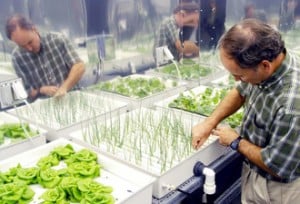There is no shortage of ideas when it comes to thinking of ways to get air pollution under control. I’m not going to say in doing so it won’t take work. It will. Now, add to this a dash of innovation here and a dash of inventiveness there, and talk about light at the end of the tunnel. That’s it.
About town
![320px-Salt_Lake_City_panorama[1]](https://alankandel.scienceblog.com/files/2012/11/320px-Salt_Lake_City_panorama1.jpg)
Meanwhile, in the handling and hauling processes there is a certain amount of emissions that are, well, emitted, produced from the waste-collection entity in doing its job.
End of story? It very well could be. But, it doesn’t have to be.
Thinking outside the waste bin for a moment, what if a program existed whereby there was incentive for the entity collecting the waste to encourage or even enable the emissions from its collection and haulage operations to be significantly lowered?
So, what are we talking about here, exactly? One approach that could fit the bill is the procurement of cleaner-burning, less-polluting equipment. Say, the waste collecting, handling and processing outfit in question is able to purchase new trucks and what-not, but only a few at a time. Maybe also the investment for said equipment is greater compared to what so-called “standard” equipment would be. Looking on the plus side, over time there would be less expenditure for fuel because truck types that are cleaner-burning, it is a good bet that they are also more fuel-efficient. What’s more, if in purchasing equipment that is easier on the environment and better from a public-health point of view, there is the strong possibility of such company owning such equipment qualifying for a rebate. It’s not unheard of for rebates to be made available, either offered by the equipment manufacturer or a distributor of such, or even by an air quality/pollution control/management district.
Okay, so now the question becomes where the money to allow for such rebates would come from or what the source for such could be, in other words.
Here’s an idea.
I drive a car. Even though its emissions are considered ultra-low, it still pollutes. Depending on how much I drive (or more appropriately how many miles I put on it over the course of a year) this could be the basis for a charge being levied on the vehicle. Obviously, the more the vehicle is driven, the more emissions would be produced and a fee could be assessed based off of that. Another approach would be to charge a set amount, identical to what others in the region would be charged.
So, getting back to the commercial operation example, at the end of the day, the monies collected could be the very same that could be used to help provide funds for the above-mentioned rebates. Over the long-term drivers would be driving cleaner-burning or emissions-free motor vehicles and air would improve all as a result. And these rebates or incentives would not just be limited to owners of commercial vehicles but to owners of passenger vehicles too.
Along with this, perhaps there is opportunity for owners/operators of said equipment to get a cost break on insurance coverage, simply because the vehicles driven and operated are easier on the environment and on people’s respiratory and cardiovascular systems. As a result, maybe there are likely to be reduced health costs related to community residents where such efforts are in effect. I just do not see why such a program, if put in place, would not be worthwhile.
At home
Immediately coming to mind is yard work. Here again, more environmentally friendly means of taking care of the lawn/yard is really as easy as one, two, three.
![SolarpanelBp[1]](https://alankandel.scienceblog.com/files/2012/12/SolarpanelBp1-300x168.jpg)
Two: lawnmower owner turns in an existing mower and in response is presented with coupon to be redeemed on the purchase of new mower. At the same time a discount is given or a brand new mower is offered at no charge depending on the exchange program terms and conditions.
Three: lawnmower owner mails coupon to mower manufacturer in question and new mower is delivered to said mower owner.
This is exactly the protocol I followed when I took part in an exchange program of this nature.
For the house, meanwhile, the addition of a photovoltaic system, whether purchased or leased, also helps.
Of course, there are the specifics to be worked through, but many people and businesses are getting and have already gotten with the solar-system program.
On the job
What about in the workplace? For employers who participate in efforts to encourage employees to lead healthier lives, the presumption here being a healthier workforce and work environment is conducive to yielding greater productivity levels, well, there is obviously something to be said regarding an approach like this.

There is also the presumption that increased productivity leads to business uptick regardless of type. And, this could lead to upped payrolls. Now the breadwinner, instead of earning less, now earns more. Perhaps as an outgrowth, a so-affected employee who maybe lives a good distance from work will now have the means to move closer to their job, providing for a shorter commute. Because the driving distance is cut, transportation expenses are lowered. The time for commuting being less, this might enable this person more time to spend with family and/or friends. There are any number of benefits that can be had.
Moreover, a shorter commute translates into fewer emissions being put into the air, that is, unless the affected worker already makes use of active transportation (on foot or by bike) in getting back and forth between home and work.
Creating opportunities for less environmental damage whether about town, at home or on the job works for me.
Image at bottom: NASA/Kennedy Space Center
– Alan Kandel